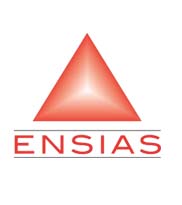- Accueil
-
L'Ecole
-
FORMATIONS
-
FORMATION INGENIEUR
-
Nouvelles filières offertes
- Ingénierie Intelligence Artificielle (2IA)
- Smart Supply Chain & Logistics (2SCL)
- Business Intelligence & Analytics (BI&A)
- Cybersécurité, Cloud et Informatique Mobile (CSCC)
- Data and Software Sciences (D2S)
- Génie de la Data (GD)
- Génie Logiciel (GL)
- Ingénierie Digitale pour la Finance (IDF)
- Smart System Engineering (SSE)
- REGLEMENT DES ETUDES DE L’ENSIAS CYCLE INGENIEUR
-
Nouvelles filières offertes
-
FORMATION INGENIEUR
- FORMATION CONTINUE
-
Recherche
- INTERNATIONAL
- ENTREPRISES
- VIE ESTUDIANTINE
- BIBLIOTHEQUE
LES DERNIÈRES INFORMATIONS
UAV for IoT Communications: Beam Selection Using Matching Game and Network Slicing
| Titre | UAV for IoT Communications: Beam Selection Using Matching Game and Network Slicing |
| Publication Type | Conference Paper |
| Year of Publication | 2020 |
| Authors | Brihi, S, Ghamizi, A, Chakri, K |
| Conference Name | Proceedings - 2020 International Conference on Wireless Networks and Mobile Communications, WINCOM 2020 |
| Mots-clés | 5G mobile communication systems, Antennas, Beam selection, Cellular communication networks, Communication beams, Computation theory, Flying relay unmanned aerial vehicle, Game theory, Internet of things, Matching game, Matching networks, Network communications, Network features, Network function virtualization, Network slicing, SDN, Unmanned aerial vehicles (UAV) |
| Abstract | In cellular communication networks, researchers are trying to improve network communication and adapt it to meet the requirements of new technologies such as the Internet of Things. The next generation of wireless networks (5G) promises new network features such as low latency, peripheral computing and radio convergence that will pave the way for a world that is ubiquitously connected. In this context and for the provision of the necessary high-quality services and connection, continuously and everywhere, even under poor network conditions, any network failures must be managed quickly and efficiently. Covering the network in remote areas, providing services in overcrowded areas, or safeguarding the network in the event of damage to the cellular infrastructure (for example, a physical disaster) are a number of challenges. In this paper we discuss the architecture and possible applications of flight modes as a part of a 5G network supporting network splitting and lightweight virtualization at the extent of relay Unmanned Aerial Vehicles (UAVs) as being small cells. It also provides 5G aerial measurement results to support the feasibility check of UAV use in two possible scenarios, namely improving the position of UAVs relative to the position and circulation of users (UEs) additionally because the increased network coverage through algorithms supported theory of games. © 2020 IEEE. |
| URL | https://www.scopus.com/inward/record.uri?eid=2-s2.0-85098730582&doi=10.1109%2fWINCOM50532.2020.9272510&partnerID=40&md5=2fd59efd80efa8be8e20ec7601c73dc9 |
| DOI | 10.1109/WINCOM50532.2020.9272510 |
Revues:
LIENS UTILES
Localisation
Contactez-nous
ENSIAS
 Avenue Mohammed Ben Abdallah Regragui, Madinat Al Irfane, BP 713, Agdal Rabat, Maroc
Avenue Mohammed Ben Abdallah Regragui, Madinat Al Irfane, BP 713, Agdal Rabat, Maroc
![]() Télécopie : (+212) 5 37 68 60 78
Télécopie : (+212) 5 37 68 60 78
![]() Secrétariat de direction : 06 61 48 10 97
Secrétariat de direction : 06 61 48 10 97
Secrétariat général : 06 61 34 09 27
Service des affaires financières : 06 61 44 76 79
Service des affaires estudiantines : 06 62 77 10 17 / n.mhirich@um5s.net.ma
CEDOC ST2I : 06 66 39 75 16
Résidences : 06 61 82 89 77
- Compteur de visiteurs:635,548
Education - This is a contributing Drupal Theme
Design by WeebPal.
Design by WeebPal.



































